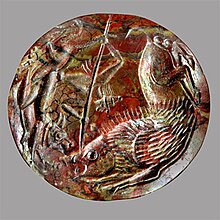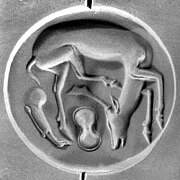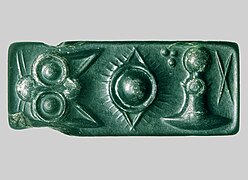Corpus of the Minoan and Mycenaean seals

The Corpus of Minoan and Mycenaean Seals (CMS) is a research project to collect and edit all Minoan and Mycenaean seals . From 1958 to 2011 as a research center of the Academy of Sciences and Literature , Mainz, located in Marburg , the project has been based at the Institute for Classical Archeology at Heidelberg University since 2011 . The current head of the corpus is Diamantis Panagiotopoulos .
Corpus
The Corpus has extensive archives with photos of the originals and impressions, as well as the motif drawings and an almost complete archive of impressions. The published pieces are available to students in the archives for research purposes.
For research into the Minoan-Mycenaean culture, the gems and seal impressions on ancient clay seals with their many figurative representations are a primary source of images. Since they are kept scattered across numerous museums and collections in Europe and America, Friedrich Matz founded the Corpus of Minoan in Marburg in 1958 and Mycenaean seal. Today the archives of the Corpus contain around 100,000 negatives, 9,000 impressions and 7,500 motif drawings. The publication work comprises 25 catalog and supplement volumes that are available in print. For each seal, photos of the original, a modern print and a motif drawing are reproduced on a larger scale. The illustrations are supplemented by descriptions and the bibliography. All photos and drawings (around 45,000 scans) are recorded in a database. So far, more than 130 researchers from 13 countries have worked in the company, including archaeologists from Germany such as Arne Eggebrecht , Manfred Korfmann , Wolf-Dietrich Niemeier , Gisela Salies and Dietrich Sürenhagen .
In 2011, the Corpus databases were integrated into the Arachne object database of the German Archaeological Institute and have since been part of a complex online retrieval system. This also contains the most important information about each seal and should enable combined queries of all entered data. The results of scientific research in the field of the Bronze Age Aegean glyptics have so far been summarized in nine supplements to the CMS.

In 2016, in the DFG project Minoan glyptic between traditional recording and 3D-forensic studies: A multidisciplinary documentation of 900 unpublished seals from the Archaeological Museum of Heraklion, the high-resolution optical 3D measurement technology was used for documentation and the GigaMesh software framework for analysis. Building on this, the BMBF project started in 2019 in the eHeritage II funding line for the development and contextualization of Aegean seals and seal impressions with 3D forensics (ErKon3D) in which digital methods for comparing seals to determine the sealing practice were developed.
Most of the Minoan seals and seal impressions on ancient clay seals are now in the Archaeological Museum of Heraklion in Crete. A large number of Mycenaean seals are kept in the National Archaeological Museum (Athens) .
With the age-related retirement of Walter Müller , who succeeded Ingo Pini from 2003 to 2011, the head office of the Corpus was relocated to the Institute for Classical Archeology at Heidelberg University . There it is directed by Diamantis Panagiotopoulos and Maria Anastasiadou.
- Editor of the CMS
- 1958–1973: Friedrich Matz
- 1964-1967: Hagen Biesantz
- 1969-2003: Ingo Pini
- 2003–2011: Walter Müller
More seals
- Seal with deer, lion's bone and 8-shaped shield (around 1500 BC, Acropolis of Mycenae)
- Cretan hieroglyphs , side of a four-sided seal (around 1800 BC, unknown origin)
Green jasper , l.1.6 cm
literature
- Corpus of the Minoan and Mycenaean seals , Berlin 1964 ff.
Web links
- Homepage of the Corpus at the University of Heidelberg
- Page of the corpus at the Mainz Academy of Sciences
- Online edition of the corpus of the Minoan and Mycenaean seals in Open Access at the Heidelberg University Library.
Remarks
- ^ Ingo Pini: The corpus of the Minoan and Mycenaean seals. In: alma mater philippina. Marburger Universitätsbund eV, winter semester 1977/78, pp. 23-25.
- ^ Ingo Pini: A short history of the corpus of the Minoan and Mycenaean seals. In: The meaning of the Minoan and Mycenaean glyptics. VI. International Seal Symposium on the occasion of the 50th anniversary of the CMS Marburg, 9.-12. October 2008 . Zabern, Mainz 2010, pp. 3–10.
- ↑ Record in the ARACHNE database for the CMS Volume: I, Seal No. 179. Retrieved on May 22, 2020 .
- ↑ DFG - GEPRIS - Minoan seal glyptic between corpus-like detection and 3D forensics. A multidisciplinary documentation of 900 unpublished seals from the Heraklion Archaeological Museum. Retrieved May 10, 2020 .
- ↑ ErKon3D - Development and contextualization of Aegean seals and seal impressions with 3D forensics. Retrieved May 10, 2020 .
- ↑ Bartosz Bogacz, Nikolas Papadimitriou, Diamantis Panagiotopoulos, Hubert Mara: Recovering and Visualizing Deformation in 3D Aegean Sealings . In: Proceedings of the 14th International Conference on Computer Vision Theory and Application (VISAPP) . Prague 2019 ( insticc.org [accessed May 10, 2020]).
- ↑ Bartosz Bogacz, Sarah Finlayson, Diamantis Panagiotopoulos, Hubert Mara: Quantifying Deformation in Aegean Sealing Practices . In: Communications in Computer and Information Science (CCIS) . 2020, p. 589-609 , doi : 10.1007 / 978-3-030-41590-7_25 ( springer.com [accessed May 10, 2020]).







